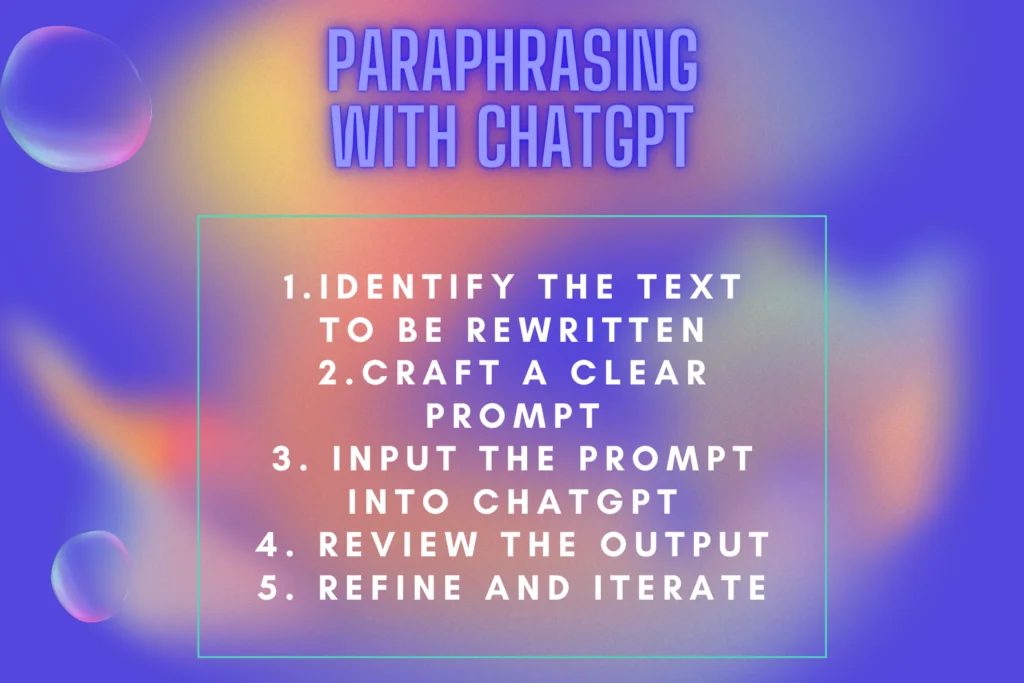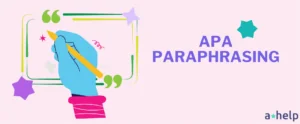Whether you’re editing an article, rephrasing a sentence for clarity, or seeking a fresh perspective on your writing, ChatGPT can be a powerful tool in your arsenal. This language model, developed by OpenAI, can assist you in creative writing, proofreading, and much more. Let’s dive into how to harness ChatGPT’s capabilities to rewrite text, so your final product is in tip-top shape, so to say.

✅ AI Essay Writer ✅ AI Detector ✅ Plagchecker ✅ Paraphraser
✅ Summarizer ✅ Citation Generator
The Specifics of Working with ChatGPT
ChatGPT has shown to be a powerful ally for many students. This AI language model, developed by OpenAI, stands out for its ability to understand and generate text that closely mirrors human communication. Its sophisticated algorithms allow it to get the context, interpret nuances, and produce coherent, contextually relevant responses. This makes ChatGPT valuable for tasks such as rewriting paragraphs, rephrasing sentences, or even generating ideas for creative writing projects.
When working with ChatGPT, remember that the quality of its output is directly influenced by the clarity and specificity of the input it receives. A well-crafted prompt that clearly outlines your rewriting objectives and any stylistic or tonal preferences can significantly enhance the relevance and accuracy of ChatGPT’s responses. For instance, if you’re aiming for a more formal tone in your rewritten text, explicitly stating this in your prompt can guide ChatGPT to produce output that aligns with your requirements.
However, while ChatGPT excels at processing language and generating text, it’s not infallible. One of the challenges you may face is that it might not always capture the subtleties of style or tone you’re aiming for. This is where your role as a discerning editor comes into play. It’s highly advised to review ChatGPT’s output critically, assessing whether it truly aligns with your intended message and voice. You may need to rethink your prompts or make adjustments to the generated text so that it meets your standards.
Prompting is Key
Knowing how to prompt is especially needed when working with ChatGPT for rewriting tasks. A well-crafted prompt acts as a clear guide for ChatGPT and makes the output meet your specific needs. Here’s how to structure a good prompt:
- Clarity
The prompt should be straightforward to understand. Avoid ambiguity so ChatGPT can accurately interpret your request. - Specificity
Be specific about what you want ChatGPT to do. Clearly state the task, such as paraphrasing, summarizing, or rewriting for a different audience. - Directness
Use direct language to convey your instructions. Carefully weigh out the options of using passive versus active voice. This helps ChatGPT to focus on the task at hand without unnecessary complexity. - Requirements
If you have specific requirements, such as maintaining a formal tone or adhering to a particular word count, include these in your prompt. - Context
Providing a bit of context can help ChatGPT understand the purpose of the rewrite and produce more relevant output.
Here’s an example of a bad prompt followed by a good one:

Bad Prompt: “Change this text.”
- This prompt is too vague. It doesn’t specify what kind of change is needed, nor does it provide any guidance on tone, style, or purpose.
Good Prompt: “Please rewrite the following paragraph more concisely, keeping the formal tone intact: [insert paragraph].”
- This prompt is clear, specific, and direct. It tells ChatGPT exactly what to do (rewrite more concisely), how to do it (maintain a formal tone), and what the task applies to (the specified paragraph).
Following these guidelines and using well-structured prompts, you can effectively communicate your rewriting needs to ChatGPT and achieve the desired results.
Step-by-Step Paraphrasing with ChatGPT
Paraphrasing text using ChatGPT involves a structured approach that transforms the original text into a new version, preserving the original meaning while altering the expression. It is particularly useful for academic writing, content creation, and clarity in communication. We decided to break it down for you so you could gain a better understanding of how to get ChatGPT to give you good paraphrasing results.

Identify the Text to Be Rewritten
The first step is selecting the specific text you wish to paraphrase. This could range from a single sentence that needs clarity, a complex paragraph loaded with information, or even an entire article that you aim to simplify or adapt for a different audience. The key here is to choose a good free paraphrase tool and a text that serves a clear purpose for your rewriting goals, whether it’s to simplify complex jargon, adjust the tone for a different audience, or avoid plagiarism by rewording original content.
Craft a Clear Prompt
Once you’ve identified the text, the next step is to write a prompt that precisely communicates your paraphrasing objectives to ChatGPT. This involves being explicit about what you’re asking the AI to do. For instance, if you’re looking for a more formal or informal tone, specify this in your prompt. If brevity is the goal, mention that the text should be condensed.
Effective prompts often include directives such as “paraphrase this text to simplify its language while retaining key technical terms” or “rewrite this paragraph in an informal tone without losing the original context.”
A well-crafted prompt sets the direction for ChatGPT, aligning the output with your expectations.
Input the Prompt into ChatGPT
With your prompt ready, the next step is to enter it into the ChatGPT interface, along with the text you’ve chosen to paraphrase. This is where the clarity and specificity of your prompt are put to the test, as the AI uses this information to generate its response. Just make sure your prompt and the text are correctly inputted. After all, you want to receive an accurate paraphrase that meets your needs, don’t you?
Review the Output
After submitting your prompt, ChatGPT will generate a paraphrased version of your text. You have to review this output thoroughly to ensure it meets your specified requirements. This includes checking for the accuracy of the information conveyed, the appropriateness of the tone and style, and the overall readability of the text. It’s also important that the paraphrased text maintains the original meaning and intent without introducing any misinterpretations or inaccuracies.
Refine and Iterate
If the initial output from ChatGPT doesn’t quite meet your expectations, this step allows you to refine your approach. You might adjust your prompt for clarity, add more specific instructions, or ask ChatGPT to focus on particular aspects of the text you feel need improvement. This iterative process enables you to hone in on the exact paraphrasing style and content you’re aiming for. Through successive refinements, you can guide ChatGPT to produce a paraphrased text that aligns closely with your objectives.
Finalize the Text
Once you’re satisfied with the paraphrased text, the final step is to finalize it for your intended use. This might involve integrating the paraphrased text into a larger document, using it as content for a presentation, or incorporating it into study materials. At this stage, it’s also wise to perform a final review to be certain that the text seamlessly fits within its new context, maintaining coherence and consistency with the surrounding content.
Conclusion
Rewriting text with ChatGPT can be a seamless when approached correctly. Remember, the key to success lies in clear, specific prompts and an iterative approach to refinement. With these tools at your disposal, the possibilities for rewriting and improving your text are virtually limitless.
FAQ
Follow us on Reddit for more insights and updates.





Comments (0)
Welcome to A*Help comments!
We’re all about debate and discussion at A*Help.
We value the diverse opinions of users, so you may find points of view that you don’t agree with. And that’s cool. However, there are certain things we’re not OK with: attempts to manipulate our data in any way, for example, or the posting of discriminative, offensive, hateful, or disparaging material.